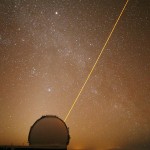W. M. Keck Observatory press release…

“For the past 10 years, the NASA KOA team has boosted the science value of data acquired at Keck Observatory by providing the scientific community with open access to WMKO data,” said Mario Perez, Keck Observatory Program Executive at NASA Headquarters in Washington. “They helped set a standard that all new ground based observatories are adopting. For this, the NASA KOA team has earned the NASA Group Achievement Award.”
“We are very proud of this award as well as the KOA project itself,” said Hilton Lewis, Director of W. M. Keck Observatory. “This was the brainchild of Anne Kinney while she was at NASA and who I am happy to report recently joined Keck Observatory as our Chief Scientist. Thanks to her vision, data gathered by all instruments at Keck Observatory is available for everyone to use. The Keck Observatory telescopes are the most scientifically productive on Earth, responsible for gathering data used in about 300 peer-reviewed scientific papers per year – almost one per night. There are terabytes of valuable data collected over the last 20 years waiting to be mined.”
In 2004, NASA established a partnership with WMKO to acquire large volumes of data from a single instrument, the High Resolution Spectrograph (HIRES), for NASA science purposes. It is standard practice to make data from NASA’s space telescopes available to the world in a public archive, but in 2004 it was unheard of to do the same with data from a ground-based telescope. Kinney, then Director of the Astrophysics Division at NASA Headquarters, decided to start a visionary project of promoting public access to these data, and the project began by archiving NASA-acquired HIRES data.
In May 2005, Kinney signed the Keck Observatory Archive (KOA) agreement with her counterparts at the other institutions governing Keck Observatory: California Institute of Technology, the University of California, the University of Hawaii, the National Optical Astronomy Observatory, and the Jet Propulsion Laboratory. This partnership between NASA and Keck Observatory to make science data public was facilitated by the NASA Exoplanet Science Institute at Caltech.
KOA immediately expanded to archive all HIRES data, not just NASA-acquired HIRES data. Next, by agreement of the partners, KOA expanded to include additional instruments at no significant increase in cost. Other facility instruments were included, and today all ten instruments that have acquired data over the lifetime of WMKO are part of KOA’s holdings, including data acquired before the establishment of the KOA.
The groundbreaking initiative of adopting standard practices of space archives to establish a permanent public archive of ground-based data has revolutionized the ground-based astronomical community and has been a model to other observatories to increase science productivity by establishing permanent public archives.
The KOA pioneering achievements can be summarized as:
- Increasing the impact of WMKO data by providing a permanent public access to data acquired by WMKO facility instruments.
- Promoting ground-based archives by providing a compelling proof-of-concept including tens of terabytes of scientific data acquired in the last 20 years.
- Advancing scientific archival research for NASA’s support missions and projects; in 2014, twelve percent of the papers produced by WMKO have been based on archival data retrieved from KOA.
- Preserving a unique scientific legacy that includes data taken for the last two decades on a large number of different astronomical sources. For example, the historical discovery of the first exoplanets by measuring Doppler shifts were made at Keck Observatory with the HIRES instrument.
- Presently the KOA includes the data of hundreds of exoplanet initial discoveries, which are available to all for the study of exoplanets.


Where is this Data archived?
aloha
Sorry… You can find it at Keck Observatory Archive